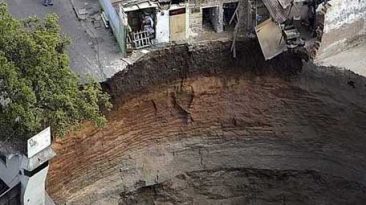Have you ever seen a shooting star? Did you make a wish? Was it for a pony? While I wouldn’t count on that wish being granted, we might be able to help out in another way. That momentary streak of light may be a beautiful sight to behold, but it could be one of many interstellar objects hurtling toward Earth on a collision course.
We’ve been hit by giant, cataclysmic asteroids before. Yet unlike the dinosaurs, you can rest assured that we’ll be better prepared.
Space debris falls to Earth from our Solar System all the time. Almost 91000 kilograms, or 100 tons per day, travels our way. So where does it all go? Well, most of it vaporizes in the atmosphere, leaving those trails of light we like to call shooting stars.
But on rare occasions, these shooting stars, or asteroids, will survive Earth’s atmosphere and plunge into the ground. Asteroids can be anywhere from 2 meters (6 feet) to a whopping 940 kilometers (583 miles) wide. To put things into perspective, an asteroid capable of a global disaster would have to be more than 0.4 km (0.25 miles) wide. Thankfully, these celestial titans are easier to detect ahead of time. But what if we couldn’t stop them?
What is the likelihood of us being hit by a giant asteroid? Where could you go to stay safe? Could scientists prevent a giant asteroid impact?
Around 800,000 years ago, a significant asteroid powerful enough to send debris and dust across the planet may have plummeted into Southeast Asia. Scientists have uncovered bizarre glassy rocks, called tektites, that were likely ejected from the impact.
These tektites have been found in Asia, Australia, and even Antarctica. This asteroid likely stirred up enough dust to block the sun for several years, destroying crops and cooling the globe. Despite the cold weather, our ancestors managed to survive this devastating impact. If NASA identified a similar asteroid that was heading our way, what should you do?
STEP ONE: Pray for a scientific breakthrough
There have been many scientific proposals to stop asteroids. We’ve thought of detonating nuclear bombs nearby, drilling bombs into them, and even attaching rockets or solar sails to the asteroid to alter its course. Who knows, maybe your career in science could help us save the planet some day. Whoever you are, thanks in advance!
STEP TWO: leave the strike area immediately.
If you live within the impact radius of the asteroid, evacuate the area as soon as possible. You’ll want to beat the traffic, so, I’m sorry, but your comic book collection can wait. Be sure to pack lots of food and water for the journey, if you have time.
If you’re heading out by car, you can expect many panicked drivers and gridlocks. You might want to consider some alternative forms of transportation. Or better yet, befriend a trained pilot.
If you can’t make it out of the impact site in time, brace yourself for intense earthquakes. Steer clear of any tall buildings and get under something sturdy to protect your head.
If you live by the ocean, you’ll want to get to higher ground immediately. Colossal tsunamis will flood coastlines, leaving a path of destruction in their wake. If you happen to be on the other side of the planet, a tsunami’s waves could take about 30 hours to arrive, so be sure to use that time wisely to prepare for the worst.
STEP THREE: Find a bunker
Even if you manage to leave the blast area safely, you’re still going to want to find shelter. If you thought earthquakes and tsunamis were bad, how about a hailstorm of flaming rocks? Debris from the asteroid impact would be absorbed in the atmosphere and then spat back out, pummeling buildings and starting fires everywhere.
You’ll want to find a shelter with reinforced concrete walls at least 30 to 80 centimeters (1-2 feet) thick. Or, if the government manages to build a biodome prior to all this, be sure to get on that waiting list early. It’s time to put those schmoozing skills to good use!
STEP FOUR: ration your food and water
Keep a stash of non-perishable food items and enough water to last you for a long time. Depending on the severity of the impact, you could be stuck in there for several years.
The dust and debris from the impact would likely trigger a nuclear winter, killing off any crops in the blast area. So consider also investing in a greenhouse for your bunker, unless you’re happy eating canned peas with every meal.
In the unfortunate event you’re stuck in a busy place when the asteroid strikes, or shopping for the latest gadgets on Black Friday, you might need to withstand a human stampede. Don’t worry, we’ve got you covered. Remember, if you want to stay alive, keep watching How To Survive.
On Friday the 13th, April 2029, the asteroid Apophis, which is approximately the size of a football stadium, has the opportunity to fly below the altitude of our communication satellites. It’s heading for a narrow range of altitudes that could either fly past the earth safely or swing back around on 2036 and plummet directly into the Pacific Ocean.
This could cause catastrophic tsunamis that would annihilate the coastlines of the Pacific Rim. Don’t worry, we have a video about that too. If you’re trying to stay alive, be sure to watch How To Survive.
Sources
- “Asteroids: Fun Facts And Information About Asteroids”. Choi, Charles. 2017. space.com.
- “How Big Does An Asteroid Have To Be To Destroy All Life?”. 2015. Inside Science.
- “Earth Impact Effects Program”. 2020. impact.ese.ic.ac.uk.
- “How To Build A Fallout Shelter”. 2020. nytimes.com.
- “We Can Survive Killer Asteroids — But It Won’t Be Easy”. WIRED.



















hi this is for a school project